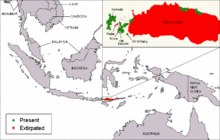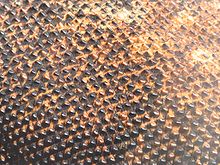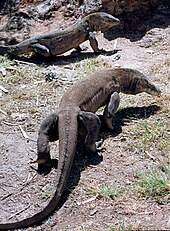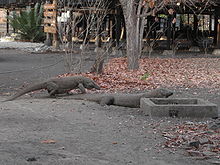This is an old revision of this page, as edited by Anthony Appleyard (talk | contribs) at 14:49, 15 July 2007 (→Parthenogenesis: Sungai). The present address (URL) is a permanent link to this revision, which may differ significantly from the current revision.
Revision as of 14:49, 15 July 2007 by Anthony Appleyard (talk | contribs) (→Parthenogenesis: Sungai)(diff) ← Previous revision | Latest revision (diff) | Newer revision → (diff)
| Komodo dragon | |
|---|---|

| |
| Conservation status | |
 Vulnerable (IUCN 3.1) | |
| Scientific classification | |
| Kingdom: | Animalia |
| Phylum: | Chordata |
| Class: | Reptilia |
| Order: | Squamata |
| Family: | Varanidae |
| Genus: | Varanus |
| Species: | V. komodoensis |
| Binomial name | |
| Varanus komodoensis Ouwens, 1912 | |

| |
| Komodo dragon distribution | |
The Komodo Dragon (Varanus komodoensis), also known as the Komodo Monitor, Komodo Island Monitor, Ora (to the natives of Komodo), or simply Komodo, is the largest living species of lizard, growing to an average length of 2-3 metres (approximately 6.5-10 feet). This great length is attributed to island gigantism, as there are no carnivorous mammals to fill the niche in the islands that they live on, and the Komodo dragon's low metabolic rate. As a result of its great size, these lizards are apex predators, dominating the ecosystems in which they live. Komodo dragons are a member of the monitor lizard family, Varanidae, and only inhabit the islands of Komodo, Rinca (or Rintja), Padar, Flores, Gili Motang, Owadi and Samiin in central Indonesia.
Parental care in Komodo dragons is restricted to the females, who guard clutches of around 20 eggs for seven months. After hatching, young Komodo dragons often move into trees in order to avoid predation by adults. Young dragons take five years to reach maturity, after which they can live for fifty years. In captivity Komodo dragons have reproduced by parthenogenesis.
In spite of their large size, Komodo dragons were only discovered by Western scientists in 1910. Their large size and fearsome reputation makes them popular zoo exhibits. In the wild their range has contracted due to human activities and they are listed as vulnerable by the IUCN. They are protected under Indonesian law and a national park was founded in order to protect them.
Anatomy and morphology

In the wild, large adults usually weigh around 70 kilograms (154 pounds). Captive specimens often weigh more. The largest verified wild specimen was 3.13 metres (10 feet 3 inches) long and weighed 166 kilograms (365 pounds), including undigested food. Komodo dragons have a tail that is as long as the body, as well as about 60 frequently-replaced serrated teeth that may be 2.5 centimetres (1 inch) in length. Their saliva will frequently be blood-tinged, because their teeth are almost completely covered by gingival tissue and this tissue is naturally lacerated during feeding. This creates an ideal culture for the virulent bacteria that live in their mouths. It also has a long, yellow, deeply-forked tongue. Males are larger than females, with skin color from dark grey to brick red, while females are more olive green, and have patches of yellow at the throat. The young are much more colorful by comparison, with yellow, green and white banding on a dark background.
Physiology

Komodo dragons' sense of hearing is not particularly acute, despite their visible earholes, and their visual discrimination (especially of stationary objects) is poor, although they can see in color. They use their tongue to detect taste and smell stimuli, as with many other reptiles, with the vomeronasal sense using a Jacobson's organ, a sense that aids navigation in the dark. With the help of a favorable wind, they may be able to detect carrion up to 9.5 kilometres (6 miles) away. Komodo dragons' nostrils are not of great use for smelling, as they do not have a diaphragm. They have no taste buds on their tongues, only a few in the back of the throat.
Their scales, some reinforced with bone, have sensory plaques connected to nerves that facilitate their sense of touch. The scales around the ears, lips, chin, and feet bottoms may have three or more sensory plaques.
Formerly, Komodo dragons were thought to be deaf when a study reported no agitation in wild Komodo dragons during whispers, raised voices, and shouts. This was disputed when London Zoological Garden employee Joan Proctor trained a captive monitor to come out to feed at the sound of her voice, even when she could not be seen.
Ecology, behavior and life history

Komodo dragons are found exclusively in Indonesia, on the island of Rinca and on several islands of the Lesser Sunda archipelago. They prefer hot and dry places, and typically live in dry open grassland, savanna and tropical forest at low elevations. As poikilotherms, they are most active in the day, although they do exhibit some nocturnal activity. Komodo dragons are largely solitary, coming together only to breed and eat. They are capable of running rapidly in brief sprints (up to 20 kilometres per hour ), are excellent swimmers (may dive up to 4.5 metres ), and climb trees proficiently through use of their strong claws. To catch prey that is out of reach, they may stand on their hind legs and use their tail as a support. As Komodo dragons mature, their claws are used primarily as weapons, as their great mass makes climbing impractical.
For shelter, dragons dig holes that can measure from 1-3 metres (3-10 feet) wide with their powerful forelimbs and claws. Because of their large size and habit of sleeping in these holes, Komodo dragons are able to conserve body heat throughout the night and minimize their basking period the morning after.
Feeding ecology

Komodo dragons are carnivorous. Although they eat mostly carrion, studies show that they also hunt live prey with a stealthy approach followed by a sudden short charge. When suitable prey arrives near its ambush site, it will suddenly charge at the animal and go for the underside or the throat.
Komodo dragons have not traditionally been considered venomous, but it has recently been suggested that they may produce a weak venom. In addition to the possible venom, dragons also possess virulent bacteria in their saliva, of which more than 28 Gram-negative and 29 Gram-positive strains have been isolated. These bacteria cause septicemia in their victim; if an initial bite does not kill the prey animal and it escapes, it will commonly succumb within a week to the resulting infection. The lizard is able to locate its prey using its keen sense of smell, which can locate a dead or dying animal from a range of up to 9.5 kilometers (6 miles). The Komodo dragon appears to be immune to its resident bacteria.

Komodo dragons eat by tearing large chunks of flesh and swallowing them whole while holding the carcass down with their forelegs. The copious amounts of red saliva that the Komodo dragons produce helps to lubricate the food, but swallowing is still a long process (15-20 minutes to swallow a goat). To prevent itself from suffocating while swallowing, it breathes using a small tube under the tongue that connects to the lungs. The Komodo dragon's loosely articulated jaws, flexible skull, and expandable stomach allows it to eat up to 80 percent of its body weight in one meal. After eating, it drags itself to a sunny spot to speed digestion, as the food could rot and poison the dragon if left undigested for too long. Because of their slow metabolism, large dragons can survive on as little as 12 meals a year. After digestion, the Komodo Dragon regurgitates a mass of horns, hair, and teeth known as the gastric pellet, which is covered in malodorous mucus. After regurgitating the gastric pellet, it rubs its face in the dirt or on bushes to get rid of the mucus, suggesting that it, like humans, does not relish the scent of its own mucus.
The largest animals generally eat first, while the smaller ones follow a hierarchy. The largest male asserts his dominance and the smaller males their submission by use of body language and rumbling hisses. Dragons of equal size may resort to "wrestling." Losers usually retreat, though have been known to have been killed and eaten by victors.
The dragon's diet is wide-ranging, and includes invertebrates, other reptiles (including smaller dragons), birds, bird eggs, small mammals, monkeys, wild boars, goats, deer, horses, and water buffalos. Young Komodos will eat insects, eggs, geckoes, and small mammals. Occasionally they have been known to consume humans and human corpses, digging up bodies from shallow graves to do so. It is thought that the Komodo Dragon evolved to feed on the extinct dwarf elephant Stegodon that once lived on Flores.
The Komodo dragon has been observed intentionally startling a pregnant deer in the hopes of a miscarriage whose remains they can eat, a technique that has also been observed in large African predators.
Because the Komodo dragon does not have a diaphragm, it cannot suck water when drinking, nor can it lap water with its tongue. Instead, it drinks by taking a mouthful of water, lifting its head, and letting the water run down its throat.
Life history

Mating occurs between May and August, with the eggs laid in September. During this period, males fight over females and territory by grappling with one another upon their hind legs with the loser eventually being pinned to the ground. These males may vomit or defecate when preparing for the fight. The winner of the fight will then flick his long tongue at the female to gain information about her receptivity. Females are antagonistic and resist with their claws and teeth during the early phases of courtship. Therefore, the male must fully restrain the female during coitus to avoid being hurt. Other courtship displays include males rubbing their chins on the female, hard scratches to the back, and licking. Komodo Dragons may be monogamous and form "pair bonds," a rare behavior for lizards.
The female will lay her eggs in the burrows in the ground, cut into the side of a hill or in the abandoned nesting mounds of the Orange-footed Scrubfowl ( a moundbuilder or megapode), with a preference for the abandoned mounds. Clutches contain an average of 20 eggs which have an incubation period of 7-8 months. The female lies on the eggs to incubate and protect them until they hatch around April, at the end of the rainy season when insects are plentiful.
Hatching is an exhausting effort for the pups, who break out of their eggshells with an egg tooth that falls off after the job is done. After cutting out the exhausted hatchlings may lie in their eggshells for hours before starting to dig out of the nest. They are born quite defenseless, and many are eaten by predators.
Young Komodo dragons spend much of their first few years in trees, where they are relatively safe from predators, including cannibalistic adults, who make juvenile dragons 10 percent of their diet. When the young must approach a kill, they roll around in fecal matter and rest in the intestines of eviscerated animals to deter these hungry adults. Dragons take about three to five years to mature, and may live for up to 50 years.
There are recorded examples of parthenogenesis (reproduction without the contribution of a male), a phenomenon also known to occur in some other reptile species, such as Whiptail Lizards.
Parthenogenesis

Sungai, a Komodo Dragon at London Zoo, laid a clutch of eggs in early 2006 after being separated from males for more than two years. Scientists initially assumed that she had been able to store sperm from her earlier encounter with a male, an adaptation known as superfecundation.
On December 20, 2006, it was reported that Flora, a captive Komodo Dragon living in the Chester Zoo in England, is the second known Komodo dragon to have laid unfertilized eggs which developed and hatched, via the process of parthenogenesis: she laid 11 eggs, and 7 of them hatched. Scientists at Liverpool University in northern England verified by means of genetic tests on three eggs that collapsed after being moved to an incubator that Flora had had no physical contact with a male dragon. After being told of the condition of Flora's eggs, testing showed that Sungai's eggs were also produced without outside fertilization. On 24, January 2007, zoo officials announced that 7 of Flora's eggs had hatched, and that the hatchlings, all male, were doing well in a new enclosure prepared for them.
However, unless there is proof that any of Sungai's eggs hatched, this is no proof of parthenogenesis in Sungai, as unmated oviparous female animals and birds often lay infertile eggs.
Komodo dragons have the ZW chromosomal sex-determination system, not the mammalian XY system. That her progeny were male, shows that Flora's unfertilized eggs were haploid and doubled their chromosomes later to become diploid, and that she did not lay diploid eggs as would have happened if one of the meiosis reduction-divisions in her ovaries had failed, and that the egg was not fertilized by a polar body. When a female Komodo dragon (with ZW sex chromosomes) reproduces in this manner, she provides her progeny with only one chromosome from each of her pairs of chromosomes, including only one of her two sex chromosomes. This single set of chromosomes is duplicated in the egg, which develops parthenogenetically. Eggs receiving a Z chromosome become ZZ (male); those receiving a W chromosome become WW and fail to develop.
It has been hypothesized that this reproductive adaptation allows a single female to enter an isolated ecological niche (such as an island) and by parthenogenesis produce male offspring, thereby establishing a sexually reproducing population (via reproduction with her offspring that can result in both male and female young).
Dragons and humans
Discovery
Dragons were first documented by Europeans in 1910. Widespread notoriety came after 1912, in which Peter Ouwens, the director of the Zoological Museum at Bogor, Java, published a paper on the topic after receiving a photo and a skin. Later, the Komodo dragon was the driving factor for an expedition to Komodo Island by W. Douglas Burden in 1926. After returning with 12 preserved specimens and 2 live dragons, this expedition provided the inspiration for the 1933 movie King Kong. Three of these specimens were stuffed and are still on display in the American Museum of Natural History.
Conservation

The Komodo dragon is a vulnerable species and is found on the IUCN Red List. There are approximately 4000-5000 living Komodo dragons. Their populations are restricted to the islands of Rinca (1,300) and Gili Motang (100) and several of the Lesser Sunda Islands, including Komodo (1,700) and Flores (perhaps 2,000). However, there are concerns that there may presently be only 350 breeding females. To address these concerns, the Komodo National Park was founded in 1980 to protect Komodo dragon populations on islands including Komodo, Rinca, and Padar. However, there is evidence that Komodo dragons are becoming accustomed to human presence, as they are often fed animal carcasses at several feeding stations by tourists.
Volcanic activity, earthquakes, loss of habitat, fire (the population at Padar was almost destroyed because of a wildfire), loss of prey, tourism, and poaching have all contributed to the vulnerable status of the Komodo Dragon. Under CITES (the Convention on International Trade in Endangered Species), commercial trade of skins or specimens is illegal.
Although attacks are very rare, Komodo dragons have been known to kill humans. On June 4 2007, a Komodo dragon attacked an eight year old boy in Komodo Island, who later died of massive bleeding from his wounds. It was the first recorded deadly attack in 33 years.
In captivity

Komodo dragons have long been great zoo attractions, where their size and reputation make them popular exhibits. However, they are rare because they are susceptible to infection and parasitic disease, and do not readily reproduce.
It has been observed in captive dragons that many individuals display relatively tame behavior within a short period of time in captivity. Many occurrences are reported where keepers have brought the animals out of their enclosures to interact with zoo visitors, including young children, to no harmful effect. Dragons are also capable of recognizing individual humans. Ruston Hartdegen of the Dallas Zoo reported that their monitors reacted differently when presented with their regular keeper, a more or less familiar keeper, or a completely unfamiliar keeper.
Research with captive dragons has also provided evidence that Komodo Dragons engage in play. These studies studied a dragon who would push a shovel left by its keeper, apparently attracted to the sound of it scraping across the rocky surface. In addition, a young female dragon at the National Zoo in Washington, D.C. would grab and shake various objects including statues, beverage cans, plastic rings and blankets; as well as insert her head into boxes, shoes, and other objects. She did not confuse these objects for food, as she would only swallow them if covered in rat blood. This social play has led to a striking comparison with mammalian play.
However, even seemingly docile dragons may act unpredictably aggressively, especially when the animal's territory is invaded by someone unfamiliar. In June 2001, a dragon seriously injured Phil Bronstein - executive editor of the San Francisco Chronicle and then-husband of film actress Sharon Stone - when Bronstein entered its enclosure at the Los Angeles Zoo after being invited in by the dragon's zookeeper. He was bitten on his bare foot, as the keeper had told him to take off his white shoes, which could have potentially excited the dragon.
Media
Videos of Varanus komodoensis at Disney's Animal Kingdom Template:Multi-video start Template:Multi-video item Template:Multi-video item Template:Multi-video item Template:Multi-video end
See also
- Island gigantism
- Megalania prisca - A huge extinct Varanid lizard
- European dragon
- Monitor lizard
- Parthenogenesis
References
- "Varanus komodoensis". Integrated Taxonomic Information System. 19 June.
{{cite web}}: Check date values in:|date=and|year=/|date=mismatch (help) - ^ Endangered! Ora URL accessed January 15, 2007.
- ^ Chris Mattison, (1989 & 1992). Lizards of the World (Of the World). New York: Facts on File. pp. pp. 16, 57, 99, 175. ISBN 0-8160-5716-8.
{{cite book}}:|pages=has extra text (help); Check date values in:|year=(help)CS1 maint: extra punctuation (link) CS1 maint: year (link) - Burness G, Diamond J, Flannery T (2001). "Dinosaurs, dragons, and dwarfs: the evolution of maximal body size". Proc Natl Acad Sci U S A. 98 (25): 14518–23. PMID 11724953.
{{cite journal}}: CS1 maint: multiple names: authors list (link) - ^ Tim Halliday (Editor), Kraig Adler (Editor). Firefly Encyclopedia of Reptiles and Amphibians. Hove: Firefly Books Ltd. pp. 112, 113, 144, 147, 168, 169. ISBN 1-55297-613-0.
{{cite book}}:|author=has generic name (help) - ^ Sedgewick County Zoo information about Varanus Komodoensis URL accessed December 21, 2006.
- ^ Burnie, David (2001). Animal. New York, New York: DK Publishing, Inc. p. 420. ISBN 0-7894-7764-5.
{{cite book}}: Unknown parameter|coauthors=ignored (|author=suggested) (help) - ^ Ciofi, Claudia. The Komodo Dragon. Scientific American, March 1999. URL accessed December 21, 2006
- Whozoo Komodo Dragon URL accessed December 21, 2006.
- ^ Tara Darling (Illustrator). Komodo Dragon: On Location (Darling, Kathy. on Location.). Lothrop, Lee and Shepard Books. ISBN 0-688-13777-6.
- Komodo Dragon URL accessed December 21, 2006.
- ^ Komodo Dragon - Background URL accessed April 13, 2007
- ^ Zipcodezoo.com - Varanus komodoensis URL accessed February 1, 2007.
- ^ text by David Badger; photography by John Netherton (2002). Lizards: a natural history of some uncommon creatures, extraordinary chameleons, iguanas, geckos, and more. Stillwater, MN: Voyageur Press. pp. 32, 52, 78, 81, 84, 140–145, 151. ISBN 0-89658-520-4.
{{cite book}}: CS1 maint: multiple names: authors list (link) - ^ The Biogeography of the Komodo Dragon URL accessed February 24, 2007.
- ^ consultant editors, Harold G. Cogger & Richard G. Zweifel; illustrations by David Kirshner (1998). Encyclopedia of reptiles & amphibians. Boston: Academic Press. pp. 132, 157–8. ISBN 0-12-178560-2.
{{cite book}}:|author=has generic name (help)CS1 maint: multiple names: authors list (link) - Eric R. Pianka and Laurie J. Vitt; with a foreword by Harry W. Greene (2003). Lizards: windows to the evolution of diversity. Berkeley: University of California Press. p. 244. ISBN 0-520-23401-4.
{{cite book}}: CS1 maint: multiple names: authors list (link) - Fry, B. G. (2006). "Early evolution of the venom system in lizards and snakes". Nature. 439: 584–588.
{{cite journal}}: Unknown parameter|coauthors=ignored (|author=suggested) (help); Unknown parameter|quotes=ignored (help) - Montgomery JM, Gillespie D, Sastrawan P, Fredeking TM, Stewart GL (2002) "Aerobic salivary bacteria in wild and captive Komodo dragons" Journal of Wildlife Diseases 38 (3): 545-551
- ^ The Reptipage: Komodo dragons URL accessed February 13, 2007.
- ^ Diamond, J (1987) "Did Komodo dragons evolve to eat pygmy elephants?" Nature 326(6116): 832-832
- Komodo Dragon: Varanus komodoensis 1998 URL accessed January 24, 2007.
- Jessop TS, Sumner J, Rudiharto H, Purwandana D, Imansyah MJ, Phillips JA (2004) "Distribution, use and selection of nest type by Komodo Dragons" Biological Conservation 117 (5): 463-470
- ^ Facts and Data on the Komodo Dragon URL accessed January 5, 2006.
- Notice by her cage in Chester Zoo in England
- ^ Komodo dragon proud mum (and dad) of five
- ^ Virgin births for giant lizards
- The Virtual Exploration Society: the Burden Expedition to Komodo Island URL accessed March 18, 2007.
- American Museum of Natural History: Komodo Dragons. Retrieved 7 June 2007.
- Template:IUCN2006 Listed as Vulnerable (VU B1+2cde v2.3) URL accessed December 21, 2006
- The official website of Komodo National Park URL accessed February 2, 2007.
- Press, Associated. "Komodo Dragon Kills Boy, 8, in Indonesia." MSNBC. 4 June 2007. . retrieved on 7 June 2007.
- Procter, J. B. 1928. On a living Komodo Dragon Varanus komodensis Ouwens, exhibited at the Scientific Meeting, October 23rd, 1928. Proc. Zool. Soc. London 1928:1017-1019.
- Lederer, G. 1931. Erkennen wechselwarme Tiere ihren Pfleger? Wochenschr. Aquar.-Terrarienkunde 28: 636-638.
- Murphy, J., and Walsh, T., 2006. Dragons and Humans. Herpetological Review, 37: 269-275.
- Transcript: Sharon Stone vs. the Komodo Dragon
- Phillip T. Robinson (2004). Life at the zoo: behind the scenes with the animal doctors. New York: Columbia University Press. p. 79. ISBN 0-231-13248-4.
Further reading
- King, Dennis & Green, Brian. 1999. Goannas: The Biology of Varanid Lizards. University of New South Wales Press. ISBN 0-86840-456-X
- Richard L. Lutz, Judy Marie Lutz,. Komodo, the Living Dragon: The Living Dragon. Salem, Or: DiMI Press. ISBN 0-931625-27-0.
{{cite book}}: CS1 maint: extra punctuation (link) CS1 maint: multiple names: authors list (link) - W. Douglas Burden,. Dragon Lizards of Komodo: An Expedition to the Lost World of the Dutch East Indies. Kessinger Publishing. ISBN 0-7661-6579-5.
{{cite book}}: CS1 maint: extra punctuation (link)
External links
- Discovery of venom in monitor lizards
- National Geographic NEWS: Virgin Birth Expected at Christmas -- By Komodo Dragon
- BBC NEWS: 'Virgin births' for giant lizards (Komodo Dragon)